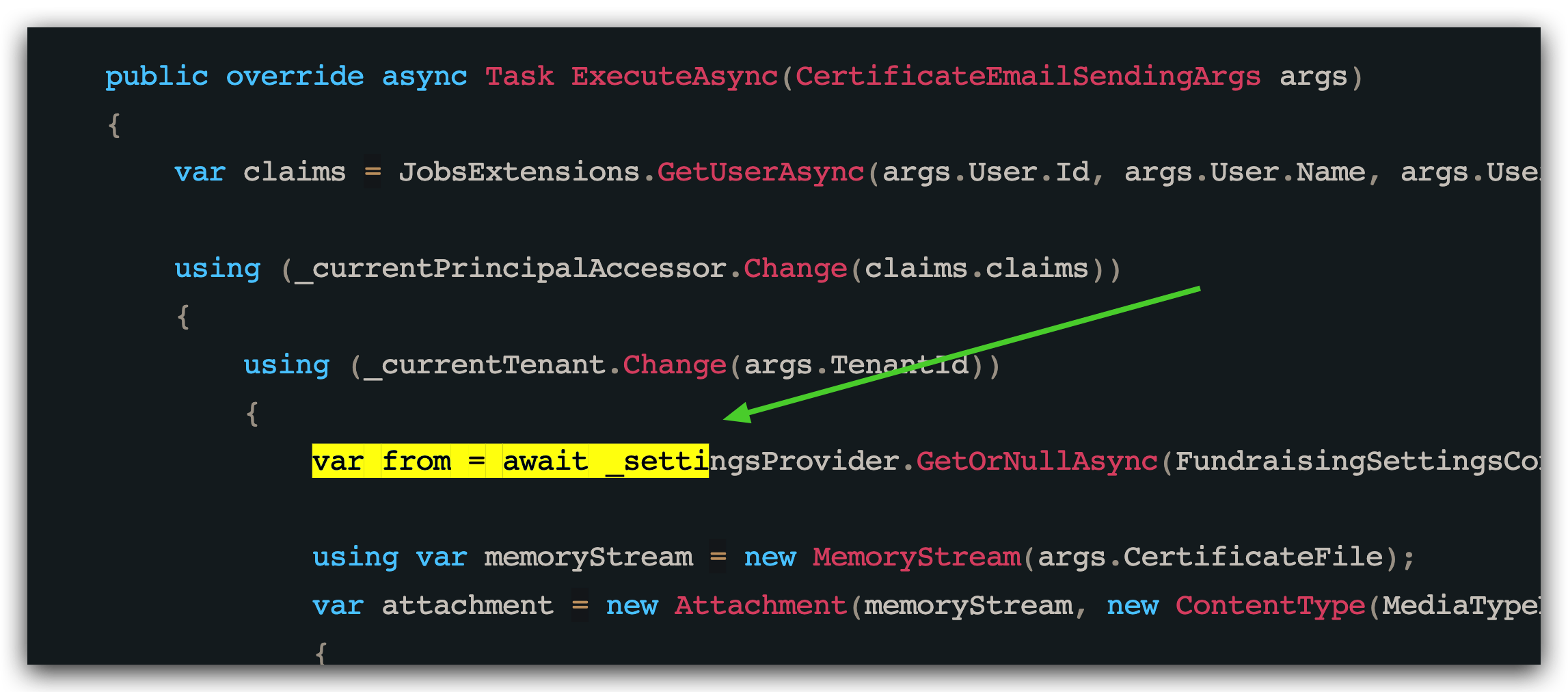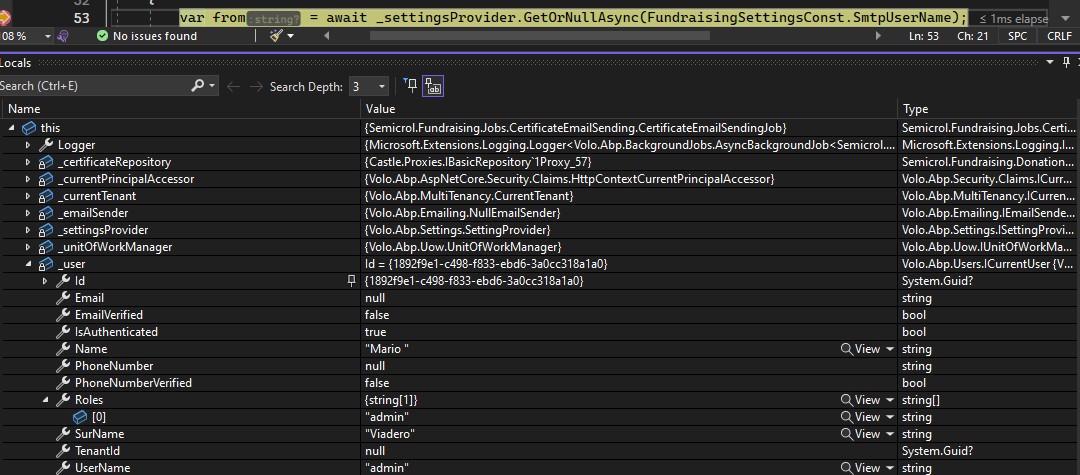- ABP Framework version: v6.0.0
- UI Type:Blazor WASM
- Database System: EF Core (SQL Server)
Hello, im using a AsyncBackgroundJob that need to query data from repositories and store after some operations that include generate a pdf document and send via email.
The fact is that injected repositories are returning empty data, watching the context Tenant is null and User is null:

The job is enqueued in an appservice method. If i use the repository in the appservices that enqueues the job, gets and store data correctly. But if the same IRepository type is injected in the backgroundjob doesnt get the data probably because tenant and user are null.
What is the correct way to use an AsyncBackgroundJob, that do some queries and store data via IRepository in a multitenant app?
Thank you!
8 Answer(s)
-
0
hi
You can add
TenantIdandUserIdto job parameters.Then
switchtenant and target user. -
0
Hi,
I'm switching tenant, with ICurrentTenant, _currentTenant.Change(args.TenantId) and TenantId is correctly stored. But switching user with ICurrentPrincipalAccessor _currentPrincipalAccessor.Change(claims) where claims are generated like this:
public static (Guid? userId, ClaimsPrincipal claims) GetUserAsync(Guid? userId, string name, string surname, string userName, string[] roleNames) { var claimsList = new List<Claim> { new(AbpClaimTypes.UserId, userId.ToString()), new(AbpClaimTypes.Name, name ?? "BackgroundJobUser"), new(AbpClaimTypes.SurName, surname ?? "BackgroundJobUser"), new(AbpClaimTypes.UserName, userName) }; claimsList.AddRange(roleNames .Select(_ => new Claim(AbpClaimTypes.Role, _)).ToList()); return (userId, new ClaimsPrincipal(new ClaimsIdentity(claimsList))); }But CreatorId still null, what am I doing wrong?
-
0
hi
Please share the full code of your
BackgroundJob. -
0
hi, yes sure, basically sends an email and then inserts a domain entity and marks as processed, or sending email error if there's an error.
public class CertificateEmailSendingJob : AsyncBackgroundJob<CertificateEmailSendingArgs>, ITransientDependency { private readonly IEmailSender _emailSender; private readonly ISettingProvider _settingsProvider; private readonly ICurrentTenant _currentTenant; private readonly IDonationCertificateRepository _certificateRepository; private readonly IUnitOfWorkManager _unitOfWorkManager; private readonly ICurrentPrincipalAccessor _currentPrincipalAccessor; public CertificateEmailSendingJob(IEmailSender emailSender, ISettingProvider settingsProvider, ICurrentTenant currentTenant, IDonationCertificateRepository certificateRepository, IUnitOfWorkManager unitOfWorkManager, ICurrentPrincipalAccessor currentPrincipalAccessor) { _emailSender = emailSender; _settingsProvider = settingsProvider; _currentTenant = currentTenant; _certificateRepository = certificateRepository; _unitOfWorkManager = unitOfWorkManager; _currentPrincipalAccessor = currentPrincipalAccessor; } public override async Task ExecuteAsync(CertificateEmailSendingArgs args) { var claims = JobsExtensions.GetUserAsync(args.User.Id, args.User.Name, args.User.Surname, args.User.UserName, args.User.Roles); using (_currentPrincipalAccessor.Change(claims.claims)) { using (_currentTenant.Change(args.TenantId)) { var from = await _settingsProvider.GetOrNullAsync(FundraisingSettingsConst.SmtpUserName); using var memoryStream = new MemoryStream(args.CertificateFile); var attachment = new Attachment(memoryStream, new ContentType(MediaTypeNames.Application.Pdf)) { ContentDisposition = { FileName = args.CertificateFileName } }; var message = new MailMessage( from, args.DonorEmail, args.EmailSubject, args.EmailBody); message.Attachments.Add(attachment); using var uow = _unitOfWorkManager.Begin( requiresNew: true, isTransactional: false); try { await _emailSender.SendAsync(message); var certificateRecord = new DonationCertificate(Guid.NewGuid(), args.DonorId, args.LabelId, args.EmailTemplateLabelId, DonationCertificateStatus.Processed, args.Year, args.DonationId); await _certificateRepository.InsertAsync(certificateRecord); } catch (Exception) { var certificateRecord = new DonationCertificate(Guid.NewGuid(), args.DonorId, args.LabelId, args.EmailTemplateLabelId, DonationCertificateStatus.EmailSendingError, args.Year, args.DonationId); await _certificateRepository.InsertAsync(certificateRecord); } await uow.CompleteAsync(); } } } } public static class JobsExtensions { public static (Guid? userId, ClaimsPrincipal claims) GetUserAsync(Guid? userId, string name, string surname, string userName, string[] roleNames) { var claimsList = new List<Claim> { new(AbpClaimTypes.UserId, userId.ToString()), new(AbpClaimTypes.Name, name ?? "BackgroundJobUser"), new(AbpClaimTypes.SurName, surname ?? "BackgroundJobUser"), new(AbpClaimTypes.UserName, userName) }; claimsList.AddRange(roleNames .Select(_ => new Claim(AbpClaimTypes.Role, _)).ToList()); return (userId, new ClaimsPrincipal(new ClaimsIdentity(claimsList))); } } public class CertificateEmailSendingArgs { public Guid? TenantId { get; set; } public string DonorEmail { get; set; } public string EmailSubject { get; set; } public string EmailBody { get; set; } public string CertificateFileName { get; set; } public byte[] CertificateFile { get; set; } public Guid DonorId { get; set; } public Guid LabelId { get; set; } public Guid EmailTemplateLabelId { get; set; } public int? Year { get; set; } public Guid? DonationId { get; set; } public UserArgs User { get; set; } } internal class DonationCertificateRepository: EfCoreRepository<FundraisingDbContext, DonationCertificate, Guid>,IDonationCertificateRepositoryI tried to switch order of change tenant and change user, same result, CreatorId is null. Something i should be doing wrong changing user, because values when i generate ClaimsPrincipal are correct.
-
0
-
0
-
0
hi
Can you prepare a project to reproduce this?
Or you can set the
CreatorIdwith your value.ObjectHelper.TrySetProperty(certificateRecord, x => x.CreatorId, () => YourId); await _certificateRepository.InsertAsync(certificateRecord); -
0
hello,
i tried this
ObjectHelper.TrySetProperty(certificateRecord, x => x.CreatorId, () => YourId); await _certificateRepository.InsertAsync(certificateRecord);And it works fine.
Thank you!




























































